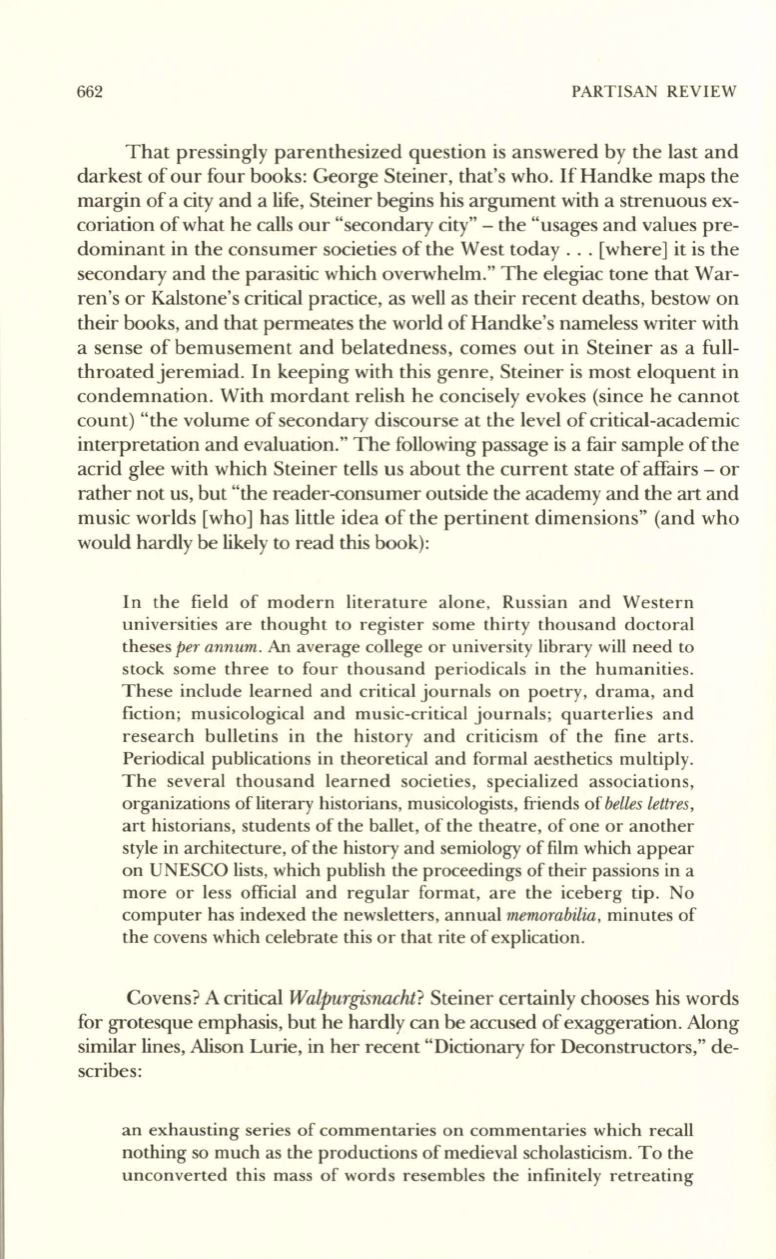
662
PARTISAN REVIEW
That pressingly parenthesized question is answered by the last and
darkest of our four books: George Steiner, that's who. If Handke maps the
margin of a city and a life, Steiner begins his argument with a strenuous ex–
coriation of what he calls our "secondary city" - the "usages and values pre–
dominant in the consumer societies of the West today ... [where] it is the
secondary and the parasitic which overwhelm." The elegiac tone that War–
ren's or Kalstone's critical practice, as well as their recent deaths, bestow on
their books, and that permeates the world of Handke's nameless writer with
a sense of bemusement and belatedness, comes out in Steiner as a full–
throated jeremiad. In keeping with this genre, Steiner is most eloquent in
condemnation. With mordant relish he concisely evokes (since he cannot
count) "the volume of secondary discourse at the level of critical-academic
interpretation and evaluation." The following passage is a fair sample of the
acrid glee with which Steiner tells us about the current state of affairs - or
rather not us, but "the reader-consumer outside the academy and the
art
and
music worlds [who] has little idea of the pertinent dimensions" (and who
would hardly be likely to read this book):
In the field of modern literature alone, Russian and Western
universities are thought to register some thirty thousand doctoral
theses
per annum.
An
average college or university library will need
to
stock some three to four thousand periodicals in the humanities.
These include learned and critical journals on poetry, drama, and
fiction; musicological and music-critical journals; quarterlies and
research bulletins in the history and criticism of the fine arts.
Periodical publications in theoretical and formal aesthetics multiply.
The several thousand learned societies, specialized associations,
organizations of literary historians, musicologists, friends of
belles leUres,
art historians, students of the ballet, of the theatre, of one or another
style in architecture, of the history and semiology of film which appear
on UNESCO lists, which publish the proceedings of their passions in a
more or less official and regular format, are the iceberg tip. No
computer has indexed the newsletters, annual
memorabilia,
minutes of
the covens which celebrate this or that rite of explication.
Covens? A critical
Walpurgisnacht?
Steiner certainly chooses his words
for grotesque emphasis, but he hardly can be accused of exaggeration. Along
similar lines, Alison Lurie, in her recent "Dictionary for Deconstructors," de–
scribes:
an exhausting series of commentaries on commentaries which recall
nothing so much as the productions of medieval scholasticism. To the
unconverted this mass of words resembles the infinitely retreating


